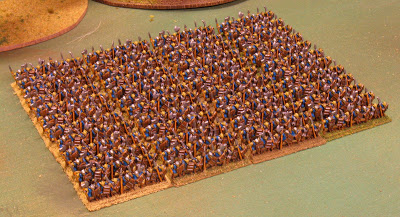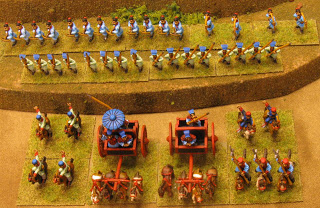I’ve finished with the humanoid armies from my Battle of Five Armies box, and started with the leaders, eagles, and bear. These were all a lot more fun than the Goblins, but I don’t feel a need to paint any more of them.
Category: project
Eureka 15mm Tlingit figures



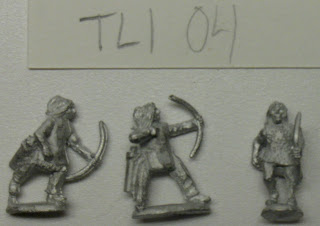
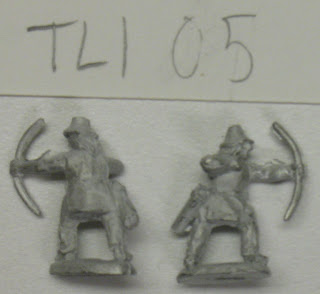



I ordered enough Eureka 15mm Tlingit figures to build DBA army IV/11: North-Western American. The elements are: 1x3Bw (Gen), 9x3Bw, 2x2Ps; and the army is Littoral, so sometimes it can drop some of the bow in the rear or flank of the enemy. Shooting entirely on the rear edge, anyone?
I am inspired to build this army mainly because my sister Sarah fled to Alaska after college and never looked back. Now, she’s living in Sitka, where the Battle of Sitka took place in 1804 between Tlingit warriors and Russian traders with the help of the Russian navy. That time period is well outside the scope of the DBA rule set, but the Tlingit lived in the area long before the Russians ever arrived.
These warriors were equipped in a very unique way, with wooden helmets in the form of animal heads, and wooden slat armor. I’d like to do a reasonable job painting them accurately, with the understanding that I’m not capable of reproducing much detail on masks that are only 3-4mm high.
The figures come in several different combinations of weapons and armor. I’m not sure if all of the sculpts are accurate or not, or if the DBA army list (primarily massed bowmen) represents the actual fighting style used by the Tlingit in the 12-14th centuries. Unfortunately, this selection of figures and army list definition are the only choice I have right now. If there are any major problems, I’m sure Slingshot, the publication of the Society of Ancients, would publish an article containing any better information that is available.
The main features I need to know how to color correctly are:
- I think the wooden slat armor is natural wood colored.
- The skin armor/clothing seems to either have the fur on the inside, or to be scraped clean; some have fur edges on the bottom. I don’t know whether these would be “natural” skin color, or whether they’d have designs painted on them.
- There are several wooden masks in animal forms, and an odd one (in the image TLI 03) that looks a bit like an upturned colander or medieval great helm. I understand these are typically painted in a light blue (turquoise? copper oxide?), black, and red (iron oxide?), but I’m not sure what patterns should be used (or whether I can pull them off in 15mm scale anyway). I’m also not sure if the hemet in TLI 03 is accurate or not.
- The conical wooden hats seem to be almost the correct shape compared to pictures I’ve seen, but I don’t know if they’d be worn in battle or what color they should be.
- What material would knives and spear points be made of, prior to European contact? Or would they be unavailable that early?
- I presume the sword-like implement is actually a wooden club?
- I’m not sure whether bows, clubs, and spear shafts would be plain wood, or painted. My initial inclination is to use my standard ochre yellow “wood-like color” for all of them.
So, Sarah: Please tell me if these pictures are any better than the ones already available on Eureka’s web site. I don’t have a great photo setup, and I tend to have problems with getting proper focus in macro mode. Unpainted miniatures, especially this small, are notoriously difficult to photograph well unless you give them a black wash to bring out the highlights.
The dime is here for scale comparison purposes, for those unfamiliar with the diminutive size of 15mm figures.
Thanks!
Edit: One more thing: how are an army’s leaders distinguished from its “rank and file” soldiers, so to speak? In DBA, the army’s “general” (or army-appropriate leader) must be visually different from other similar elements.
Too Many Goblins!
I’m glad I only bought one box of Battle of the Five Armies for now, because I am totally sick of painting these tiny goblins!
This is 8 units of goblins, with 3 stands per unit and 2 rows of figures per stand, or 48 rows total. These 8 units are also a bit under 1/3 of all of the figures in the box.
As I mentioned in the Fanaticus forum: there are always too many goblins, they’re almost as bad as Romans! At least these are in 10mm scale, I don’t think I could handle painting many of these in 28mm.
The Battle of Five Armies: The Dogs
I’ve started painting figures from GW’s Battle of the Five Armies boxed game. I started with the Wolves and Goblin Warg Riders because I like dogs, and find them easy to paint. The four units of Wolves and four units of Goblin Warg Rider cavalry represent just under 1/3 of the figures in the Battle of Five Armies box.
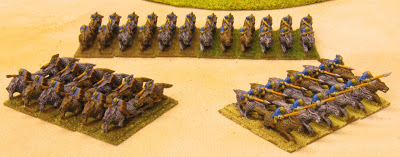 These are 10mm miniatures, quite a bit smaller than my 15mm DBA armies. This is the scale where sane people stop shading anything and resort to block colors with black lining between them. The results are quite reasonable at normal playing distance (arm’s length), but as seen in the pictures here, they’re not meant for closeups.
These are 10mm miniatures, quite a bit smaller than my 15mm DBA armies. This is the scale where sane people stop shading anything and resort to block colors with black lining between them. The results are quite reasonable at normal playing distance (arm’s length), but as seen in the pictures here, they’re not meant for closeups.
These are plastic figures, and the shape of the wolves is exactly the same as the 28mm Warhammer wolves. All of the plastics are modelled at 4x scale or larger, and then they somehow shrink them down when making the molds. The figures lose some detail on the top and bottom, since there can’t be any undercuts in the mold, but leaving black primer there hides the defect well enough.
The main complaint I have about the figures themselves is the fact that the poses are all identical. They’re packed tightly onto the bases and you can’t get much variation in their position. As far as accuracy goes: the wolves and wargs are the same models, unfortunately.
I’ve heard a theory that Tolkien’s Wargs are actually Andrewsarchus Mongoliensis. This makes sense from a morphological perspective, and I enjoy the idea and its possible implications. Although it’s hard to interpret the intent of the author when it comes to fictional works, I think that once a book is written, the interpretation of the reader is far more important than the intent of the author. Stories that stand the test of time will inevitably suffer no end of interpretations inconsistent with the author’s designs, but they will survive them all.
However, I’ve also decided that I don’t really enjoy painting these 10mm guys. It’s not hard, despite how small they seem, and it’s impressive how little paint it takes to make a figure look painted if you’re leaving black lines between the block colors. But it’s a very tedious, repetitive process. Watching (listening to?) the olympics helped a lot, but that’s over now.
I’ve finished painting the goblin infantry as well, but they aren’t all based yet, because I ran out of metal 40mm x 20mm bases until I got more tonight at Legions. That leaves “the good guys” and leaders. I’ve started the elves, but haven’t gotten very far on them yet.
Making Things to Make Things
Some folks get so caught up in building jigs that they never end up building the things they intended to make with the jig. I think this is an unfortunate position to be in: halfway between making tools, and gaining the skills appropriate to work on the project you want to finish. Although I don’t like building jigs for their own sake, many improvised tools are extremely useful to the project at hand and well worth the effort.
For example, I built this rack to hold plastic miniatures on their sprues while I’m painting them. I’ve only used it for a few days and it has already saved me more time than it took to build.
The first version used a coat hanger instead of a wooden frame, and the whole thing wobbled so much it dumped my figures on the ground. With this one I can pick it up by the top portion, and it’s well balanced and sturdy enough to carry between the attic to the porch for spraying primer and varnish.
The figures here are from my latest project: Games Workshop’s Battle of the Five Armies boxed game. It’s based on the excellent Warmaster rules (also by GW), and comes with a metric pantload of plastic 10mm figures.
Pictured on the rack here are the 4 units of goblin wolf riders, and 4 units of wolves. I like painting wolves and they go really quickly for me, so I did these first. This represents just under 1/3 of the sprues in the game, but I am guessing considerably less than 1/3 of the total time to complete painting it all. That said, the paining went more quickly than I expected on the goblins, so I have hope I’ll be able to finish all the miniatures without going insane.
This signals a shift away from DBA painting for a bit, hopefully at least until the BoFA armies are finished. I may sneak in a few elephants and rough going terrain pieces for variety. I expect I’ll eventually get back to 15mm historicals to paint DBA armies for Mongol Conquest, more Chinese, and more Alexandrian Macedonians.
DBA Army II/4: Warring States Chinese
At the same time I bought the Mountain Indian DBA army from Museum Miniatures, I also got a pack for II/4a, Warring States: Ch’in Chinese.
 The Ch’in or Qin dynasty was formed in the latter part of the 3rd century BC. The first (and only) Ch’in emperor, Qin Shi Huang, is famous for completing the first version of the Great Wall of China, standardizing the written Chinese language, and for his excessive but very archaeologically useful burial of over 8000 life sized terra cotta warriors.
The Ch’in or Qin dynasty was formed in the latter part of the 3rd century BC. The first (and only) Ch’in emperor, Qin Shi Huang, is famous for completing the first version of the Great Wall of China, standardizing the written Chinese language, and for his excessive but very archaeologically useful burial of over 8000 life sized terra cotta warriors.
The period of civil war that led to the Ch’in Dynasty was called the Warring States period for obvious reasons. When the emperor died in 210BC, China fell back into civil war for a shorter period, and the Han dynasty emerged.
 In a later order to Museum, when I was ordering some Mongols, I threw in a DBA army pack of II/4c: Chao, since I was ordering overseas (and they were on sale). The biggest difference between the armies is that II/4a has 4x4Wb, and II/4c has 4x4Sp. Ch’in soldiers are classified as warbands because they were particularly brutal on the battlefield, due to the fact that they were rewarded based on the number of enemy heads they collected during battle.
In a later order to Museum, when I was ordering some Mongols, I threw in a DBA army pack of II/4c: Chao, since I was ordering overseas (and they were on sale). The biggest difference between the armies is that II/4a has 4x4Wb, and II/4c has 4x4Sp. Ch’in soldiers are classified as warbands because they were particularly brutal on the battlefield, due to the fact that they were rewarded based on the number of enemy heads they collected during battle.
For some reason, both packs came with the same spear figures for the 4Wb and 4Sp units. Since they are enemies of each other and have few other enemies, I think this would be very consfusing in a matched pair game. So, although I started painting II/4a, I finished painting II/4c until I get some halebard figures to use as warband.
Unforuntately, Museum has a limited selection of Chinese figures. I’d like to see a sword carrying figure other than the general, to build a proper blade unit for some of the warring state armies. The figures seem very well suited to the Ch’in chinese, but Museum uses the same figures for everything from 1100BC to 189AD, which is pushing it a bit.
I am extremely happy with the way this army turned out! I think it’s one of the prettier armies I’ve painted. Some of the faces on the spear and cavalry elements are a bit muddy, but overall the colors came out clean, it pained up quickly, and it looks great.
When my halebards come, I’ll paint them up, and I’ll have enough elements to field either II/4a or 4c, and probably a few other Warring State armies. I also ordered enough supplemental figures to field a double II/4c, or Han Chinese using the same figures.
To paint the light blue and light green, I used a very light blue/green base coat, and mixed a wash of darker blue/green paint. The wash is approximately 1/3 acrylic paint, 1/3 water, and 1/3 gloss varnish (Delta Ceramcoat brand, water based craft varnish). I test for flow and coverage on my palette or an old figure, and adjust the water and varnish proportions until it flows the way I like it. When it’s working, it does a good job of filling in the low spots while leaving the high spots lighter. In the end it only requires a bit of touchup on the highlights and it’s good to go.
I’m not as fond of painting chariots. Thes turned out well, especialy the red parts, but it’s not my favorite. I used more different hair color patterns on the horses, which also turned out fairly well. But the crossbowmen, spearmen, and archers were my favorite to paint here despite their very uniform appearance.
This army just collected its first win, in a solo match versus my Skythians. I really like the balance of elements in the Chao army, but I was really hoping I’d learn something about how not to lose with the Skythians, since Battle at the Crossroads is coming up next weekend.
Last of the Later Achaemenid Persians?
Well, probably not the last, but I painted some more, anyway.
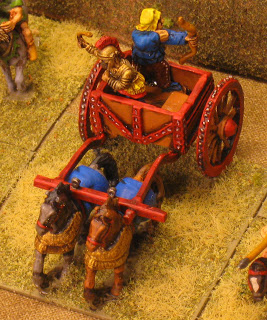 To finish off my DBA Later Achaemenid Persian triple army, I chose multipurpose figures. Based on the DBM army lists, I chose Cretan archers for the 2Ps elements, which are also allowed in Alexandrian armies, and Paphlagonian light horse for the 2LH elements. These are Magister Militum Cretan Archer figures and Paphlagonian Light Horse.
To finish off my DBA Later Achaemenid Persian triple army, I chose multipurpose figures. Based on the DBM army lists, I chose Cretan archers for the 2Ps elements, which are also allowed in Alexandrian armies, and Paphlagonian light horse for the 2LH elements. These are Magister Militum Cretan Archer figures and Paphlagonian Light Horse.
I also needed to finish one more LCh or 3Cv element, and since I already have 7 3Cv elements I settled on a chariot. I know chariots were basically unused at this point, except to help Darius III flee the battlefield more quickly, but they do look good.
The chariot is a bit of a mashup. The chariot and driver are from Magister Militum, but the chariot was originally scythed. The Magister Militum 2-horse chariot seemed even more out of place for a Persian army. The horses are from an Essex scythed chariot that will certainly not fit 4 horses across on a 40mm base. The archer is another Skythian from my Falcon army pack, painted to look pretty much just like a Persian.
This finishes the figures I need in order to field a triple Persian army. However, I’ll likely paint a few more eventually. I’d like to build a 3Ax general and a few Scythed Chariots. I’ll also paint more Hoplites, because no one can ever have too many of those (if they have any at all), and I’d rather not use Spartans as my Hoplite mercenaries.
Skythian Camp
It has become apparent that in order to prevent being ridiculed while playing DBA in public (mostly kidding), I needed to paint a separate element of Camp Followers instead of modelling camp follower figures directly on my camps. I also didn’t have a very appropriate camp for my Skythians, so I decided to kill two birds with one stone.
 This is a generic camp model, though I chose a cart based on suggestions in the Osprey Skythian book that they used a ring of carts/wagons at their camp.
This is a generic camp model, though I chose a cart based on suggestions in the Osprey Skythian book that they used a ring of carts/wagons at their camp.
The base is 80 x 40mm plywood with a sticky magnet on it. On top there’s an Essex cart, and a fire and supplies from a Museum Miniatures camp pack. I added a 20 x 40mm section of sticky magnet to hold the camp followers down.
Sticky magnets are excellent. I’ve found they’re cheapest when you buy them in the form of business card magnets.
The camp followers could double as a Psiloi element in a pinch. All Skythians had bows and knew how to use them, but they’re nomadic. So I decided archers would be more appropriate than civilians with farm implements. These archers are more Falcon miniatures left over from my army pack.
DBA Army III/10c: Hindu Indian
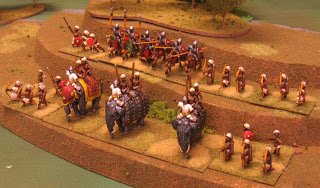 Here is my latest DBA army: Medieval Hindu Indians “other,” army III/10c. The figures are from an Essex DBA v1 army pack, and did not include the Artillery element that is optional in the DBA v2 army list.
Here is my latest DBA army: Medieval Hindu Indians “other,” army III/10c. The figures are from an Essex DBA v1 army pack, and did not include the Artillery element that is optional in the DBA v2 army list.
The army consists of 1 Elephant General (I choose the one with the red blanket), 2 Elephants, 2 Cavalry, 1 Blade, 4 Bows, and 2 Psiloi. The Artillery, if I had it, would replace one of the elephants. I have a bombard I could paint up for this army, but no appropriate crew yet.
I plan to write more about the individual Essex Elphant models soon, since I have had a horrible time finding any useful information about what they look like and how they should be painted. For now, let’s just say: these things are tanks! The two on the right are very heavily armored except for their legs.
I  tried to find information online about how the Medieval Hindu Indians should be painted, but I didn’t find anything other than other peoples’ paint jobs, and indications that they were also guessing. Off white is always a reasonable choice, or red if you need some color, since it seems to be one of the most commonly available dyes. The cavalry are the only elements that have much color (other than the elephant). I chose primarily red, with green barding and some blue shirts.
tried to find information online about how the Medieval Hindu Indians should be painted, but I didn’t find anything other than other peoples’ paint jobs, and indications that they were also guessing. Off white is always a reasonable choice, or red if you need some color, since it seems to be one of the most commonly available dyes. The cavalry are the only elements that have much color (other than the elephant). I chose primarily red, with green barding and some blue shirts.
The lances held by the left element here were molded on, so I left them until they break off. On the right, I used Xyston wire spears instead, since they had to be glued in place anyway.
 The infantry are easy: off-white butt wraps and head wraps, with red shields. I don’t even know if these figures are appropriate for medieval era Indians; I’d expect them to be wearing a bit more armor or maybe a robe. On the upside, these guys will give me a head start on Classical Indians, and they’re compatible with the Mountain Indian figures I’ve already painted.
The infantry are easy: off-white butt wraps and head wraps, with red shields. I don’t even know if these figures are appropriate for medieval era Indians; I’d expect them to be wearing a bit more armor or maybe a robe. On the upside, these guys will give me a head start on Classical Indians, and they’re compatible with the Mountain Indian figures I’ve already painted.
Was my most recently painted full DBA army Mountain Indians? It seems odd, I feel like I painted something else in between… I guess that was my 10 other DBA elements for the Persians.
Have I actually played a game of DBA since I painted the Mountain Indians? Well. Maybe 2 games, I guess… but I haven’t played with the Mountain Indians yet.
Make Your Own Game: The Game Crafter
I recently discovered a really excellent web site: The Game Crafter.
Here, you can do on-demand publishing of board games, while maintaining ownership of your creation. They have a selection of standard parts you can choose from, such as pawns, meeples, tokens, glass gems, and colored cubes. They also print and cut decks of cards, mounted game boards of certain sizes, and instruction books. Finally, they let you sell your game from their store, similar to the way a site like Cafe Press works.
I haven’t used the service or bought any games from them yet, so I can’t comment on the quality of the components they provide. However, as far as the price is concerned, this seems like an excellent way to get reasonably high quality cards printed, such that they are all an identical size (so you can shuffle them) and without running out of printer ink. The base prices seem like a manageable cost to build your own game and purchase a copy, but it seems like the margins would be really slim if you wanted to sell copies at a reasonable price.
I also discovered a similar site for books and authors: lulu.com. I’m no writer, so that one’s not as interesting to me.



